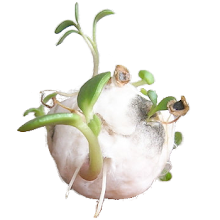A very good case for throwing some seed bombs in your urban area!
From: http://www.newenglandwild.org/blog/plant-native-plants-even-in-cities.html/
Plant Native Plants: Even in Cities
To many a gardener, cities may appear to be biological deserts: hot wastelands of concrete in summer and largely devoid of the charm of greenery, particularly in winter. But half the world’s human population lives in cities, and cities are expanding even faster than their resident populations are growing. Thus, it makes sense to evaluate the value of city “habitat” for maintaining biodiversity–the rich assemblages of plants and animals that call cities their home. Could downtown Boston, Hartford, Portland or Providence someday become native-plant meccas for birds and other critters?
A recent global analysis — the first of its kind — sought to understand whether and how cities foster plant and bird species. Myla Aronson (Rutgers University) and 23 colleagues compiled bird lists for 54 cities and urban floras for 110 cities, together spanning 36 countries on six continents. The data for many cities are surprisingly in-depth. For example, volunteer bird counts in places like New York’s Central Park, recently the focus of a wonderful documentary titled “Birders: The Central Park Effect,” have painted a clear picture of the importance for green space even in the midst of some of the most populous cities on earth.
The researchers recorded the density of thousands of plant and animal species reported in cities (expressed as number of species per square kilometer). Next, they assembled lists of the species expected to occur in nearby non-urban areas, based on published range maps of these taxa. They then explored correlations between bird and plant density and 10 factors characterizing each city, including its age, the proportion of land cover with green space, climate, geography, and topography. Interestingly, North America contained a high overall number and density of plants and birds associated with cities, second only to Indo-Malayan countries!
Perhaps surprisingly, cities harbor significant numbers of bird and plant species. Twenty percent of globally known bird species, and more than 14,000 plant species (representing 5% of the earth’s flora and 2/3 of all plant families) occur in cities.
The researchers note that cities with more open space (parks, conservation areas, and greenways) support higher proportions of the expected bird and plant species. However, other findings were more sobering: cities only support about 25% of the plant species and only 8% of birds that would be predicted to occur there based on their overall (urban and non-urban) ranges. On average, about 28% of plant species in cities around the globe are exotic to their locales. Could it be that birds and other organisms face a lack of native species in cities and therefore tend to give them a miss? What if we attracted them by planting more of the native plants on which they depend?
Reflecting on these data, the authors conclude: “Efforts directed towards conservation and restoration of native [our emphasis] vegetation within urban landscapes could support greater concentrations of both bird and plant species, ameliorating the projected declines of biodiversity with rapid urban growth…. Our results highlight that cities can support both biodiversity and people, but retaining these connections requires sustainable urban planning, conservation and education focused on each city’s unique natural resources.”
Perhaps it’s time for us to experiment. If every urbanite in New England planted one native herb, shrub, or tree, we’d be participating in a continental-scale transformation of the landscape. Pretty soon, the music of bird song could drown out the cacophony of traffic. So, urbanites: think native when planning even a stamp-sized rooftop garden!
By Elizabeth Farnsworth - Senior Research Ecologist, New England Wild Flower Society
Article discussed in this blog:
Aronson, M. F. J., F. A. La Sorte, C. H. Nilon, et al. 2014. A global analysis of the impacts of urbanization on bird and plant diversity reveals key anthropogenic drivers. Proceedings of the Royal Society of London, B Series DOI: 10.1098/rspb.2013.3330.


No comments:
Post a Comment